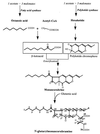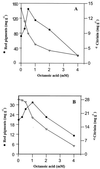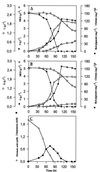Medium-chain fatty acids affect citrinin production in the filamentous fungus Monascus ruber
- PMID: 10698780
- PMCID: PMC91951
- DOI: 10.1128/AEM.66.3.1120-1125.2000
Medium-chain fatty acids affect citrinin production in the filamentous fungus Monascus ruber
Abstract
During submerged culture in the presence of glucose and glutamate, the filamentous fungus Monascus ruber produces water-soluble red pigments together with citrinin, a mycotoxin with nephrotoxic and hepatoxic effects on animals. Analysis of the (13)C-pigment molecules from mycelia cultivated with [1-(13)C]-, [2-(13)C]-, or [1, 2-(13)C]acetate by (13)C nuclear magnetic resonance indicated that the biosynthesis of the red pigments used both the polyketide pathway, to generate the chromophore structure, and the fatty acid synthesis pathway, to produce a medium-chain fatty acid (octanoic acid) which was then bound to the chromophore by a trans-esterification reaction. Hence, to enhance pigment production, we tried to short-circuit the de novo synthesis of medium-chain fatty acids by adding them to the culture broth. Of fatty acids with carbon chains ranging from 6 to 18 carbon atoms, only octanoic acid showed a 30 to 50% stimulation of red pigment production, by a mechanism which, in contrast to expectation, did not involve its direct trans-esterification on the chromophore backbone. However, the medium- and long-chain fatty acids tested were readily assimilated by the fungus, and in the case of fatty acids ranging from 8 to 12 carbon atoms, 30 to 40% of their initial amount transiently accumulated in the growth medium in the form of the corresponding methylketone 1 carbon unit shorter. Very interestingly, these fatty acids or their corresponding methylketones caused a strong reduction in, or even a complete inhibition of, citrinin production by M. ruber when they were added to the medium. Several data indicated that this effect could be due to the degradation of the newly synthesized citrinin (or an intermediate in the citrinin pathway) by hydrogen peroxide resulting from peroxisome proliferation induced by medium-chain fatty acids or methylketones.
Figures



References
-
- Armitt S, McCullough W, Roberts C F. Analysis of acetate non-utilising (acu) mutants in Aspergillus nidulans. J Gen Microbiol. 1976;92:263–282. - PubMed
-
- Bagget J M, Berndt W O. Renal and hepatic glutathione concentrations in rats after treatment with hexachloro-1,3-butadiene and citrinin. Arch Toxicol. 1984;56:46–49. - PubMed
-
- Baltazar M F, Dickinson F M, Ratledge C. Oxidation of medium-chain acyl-CoA esters by extracts of Aspergillus niger: enzymology and characterization of intermediates by HPLC. Microbiology. 1998;145:271–278. - PubMed
-
- Bilgrami K S, Sinha S P, Jeswal P. Nephrotoxic and hepatoxic effects of citrinin in mice (Mus musculus) Proc Indian Natl Sci Acad B. 1988;54:35–37.
-
- Blanc P J, Loret M O, Santerre A, Goma G. Production of citrinin by various species of Monascus. Biotechnol Lett. 1995;17:291–294.
Publication types
MeSH terms
Substances
LinkOut - more resources
Full Text Sources
Other Literature Sources

